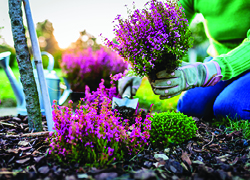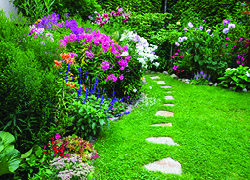
Choosing the Right Plants:
Take a look at your yard and note the sunny and shady areas. While shopping, choose plants that will offer a variety of colors. Whether you’re starting your plants from seeds or using potted plants, it’s important to read the care labels before planting. Pay attention to the plant’s sunlight and watering needs, growing season, height and spacing requirements, annual vs. perennial, and any unique features to help it to thrive in its new environment.
Location, Location, Location:
Understanding the quality of your garden’s soil is crucial when planting, so get started by exploring knowledgeable resources that will help you determine what kind of soil you have. Knowing whether the soil is well-drained and if it contains excess clay or sand can help you choose the right plants and determine the best location to plant them. In general, plants grow best in nutrient-rich soil with good drainage, and adding compost or manure can help ensure your soil is suitable for planting.
Composting vs. Mulching:
Compost is an organic, decomposed material that adds nutrients to the soil, while mulch is the thick top layer that limits weed growth and helps soil retain moisture. When using compost, make sure it has cured for a few months, so the high nitrogen content doesn’t “burn” your beautiful flower beds. Weed your garden early in the season to prevent weeds from going to seed, then apply mulch to prevent them from growing back.
Watering:
Be sure not to overwater or underwater your plants. To avoid any mishaps, check the care labels of your plants. Once you’ve planted them, feel the soil’s moisture regularly, and if the soil is dry, give your plants a deep soak. During droughts, water more frequently to compensate for the lack of rainfall. To prevent evaporation due to the sun and high temperatures, watering in the morning or evening is best.

Enjoying a Full Bloom:
Now that your garden is in full bloom, you can sit outdoors and take in all that you’ve accomplished. Invite your family and friends over to enjoy the beautiful flowers in your well-maintained garden.
Prepping for Next Year – Pruning and Deadheading:
Be sure to prune your spring plants soon after the blossoms die. If you do it in the fall or winter, you may accidentally harm the next year’s buds. To foster new growth and keep your garden tidy, pinch or cut the dead flowers from their stems. Deadheading helps plants focus their energy on growing stronger leaves and roots instead of wasting energy on developing seeds.
To learn more about how Envisage can help you navigate the changes of aging, contact Bill Hull at 412.605.4197.




